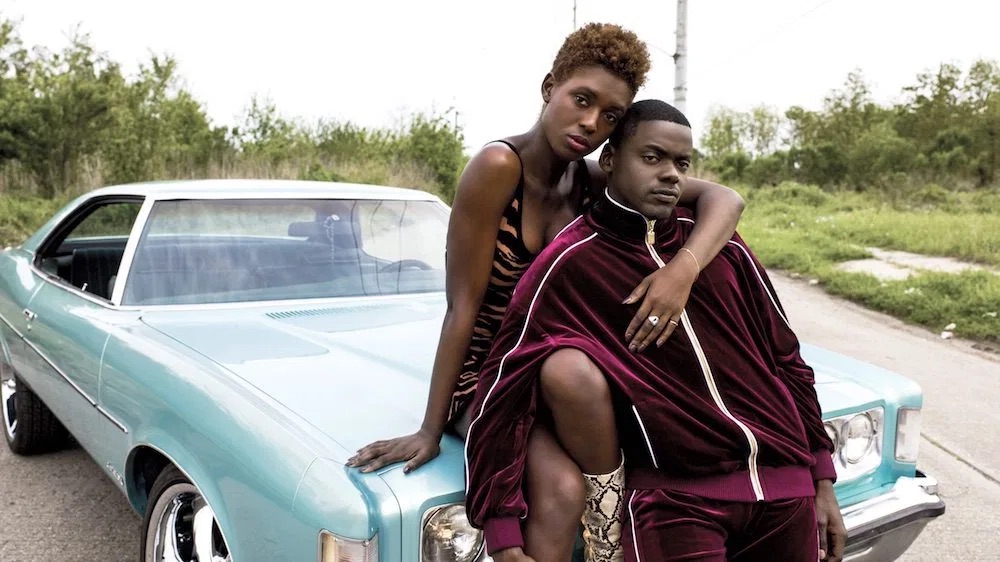
Courtesy of Universal Pictures
As black filmmakers are increasingly given the platform to share the range of stories they’ve long possessed the desire to tell (Chinonye Chukwu’s “Clemency” and Jimmie Fails’ “The Last Black Man in San Francisco” come to mind), audiences are gaining greater access to nuanced narratives of black characters. Screenwriter Lena Waithe and director Melina Matsoukas’ 2019 film, “Queen & Slim,” centralizes the splendor, the anguish and the magic of being black. While it is an imperfect film, it is a noteworthy contribution to the canon and has sparked a purposeful conversation about the responsibility films that contemplate blackness have to black people.
After their forgettable first date in the ethnoburbs of Ohio, Ernest “Slim” Hines (Daniel Kaluuya), a pleasant, bright-eyed man, and Angela “Queen” Johnson (Jodie Turner-Smith), an emotionally guarded attorney, are stopped by Officer Reed (Sturgill Simpson), a white cop. Reed antagonizes the dark-skinned duo and aggresses Slim, who ultimately shoots and kills Reed in self-defense. “Queen & Slim” follows the pair’s cross-country escape to Cuba.
The anatomy of the routine traffic stop scene should be analyzed alongside Emory Assistant Professor Calvin Warren’s essay “Black Care.” In it, Warren illustrates that the violence of racist encounters are not confined just to the instances in which they occur. Rather, violence festers, wounds remain agape and the souls of black folk never forget the numerous ways in which they are insulted, assaulted.
Matsoukas’ directoral hand effectively reflects Warren’s musings in “Queen & Slim” through her signature, tactful color gradient. As Slim is targeted by Reed and Queen is embroiled in frustration at the injustice of the encounter, the monochromatic environment visually simulates the racial tensions of the moment: black skin in a white car, black bodies thrust against white snow, black existence versus white power, the religiosity of black church and the will of human power. But as the aforementioned violence results in national media attention and the eponymous pair become mystified suburban legends among many blacks, vibrant color and the looming possibility of violence pools throughout the fatalistic world of the movie.
When Queen and Slim arrive in New Orleans to seek shelter with Queen’s Uncle Earl (Bokeem Woodbine) and his gaggle of girlfriends, the film is inculcated with azures, mauves and blood oranges. The film’s exemplary pan-African soundtrack enhances these colors with sonic signatures from the likes of Solange, Fela Kuti and Moses Sumney, whose hymn, “Doomed,” is strategically haunting. Woodbine’s character adds useful comedic elements to “Queen & Slim.” His character and environment further characterize elements of Queen’s mysterious past and reemphasize the stakes of Queen and Slim’s dilemma; these are two black strangers thrust together by circumstance. Their quest for survival surpasses the daily one their blackness ostensibly subjects them to, and the stakes that surround their potential capture become emblematic of the destiny of black America. It is in Uncle Earl’s home that Angela and Ernest begin to become Queen and Slim. It is there that they begin to know one another, to fall in love and to digest the way their fate becomes iconoclized by those who either hunt or celebrate them.
As Woodbine’s character identifies, “Queen & Slim” answers the question: what would the Bonnie and Clyde narrative look like were the infamous outlaw lovers black? But it transcends the crime genre classic by suggesting that despite the death of Reed, Queen and Slim are fugitives but not criminals. In fact, the film suggests that the greatest crime the two commit is intermittently forfeiting their humanity to stay alive while black. As the titular characters cruise toward Cuba in a teal Catalina, they make pit stops to go dancing in a Southern juke joint, have their photo taken by an admirant young fan and make love.
The implications of these gestures are meaningful — dare to embody the humanity in your blackness, even and especially in times of peril — but the dreaminess of Queen and Slim’s dialogue and the intertwining of their fingers and flesh sometimes feels unwarranted and unearned. Slim begins the film with an air of contentment.But as “Queen & Slim” progresses, he adopts a forceful burgundy-velour-suit machismo that elicits a sultry vulnerability from Queen’s prior emotionally distant persona. I suspect that we are supposed to believe their intense, shared circumstance spurs their respective changes, but the swiftness of this change makes their mostly compelling romance intermittently unbelievable. This is a situational weakness; I cannot overstate the intention and grace Turner-Smith and Kaluuya bring to their respective roles.
This complication, coupled with the film’s representations of brutalized black bodies, mixed meditations on the complicity of blacks in their own suffering and chaotic splicing of a protest scene with a climatic sex scene, “Queen & Slim” falls short of its ostensible goal: to be a graceful motion picture about the triumph of black resilience.
While some have outright praised the film’s exploration of black love, others have criticized “Queen & Slim” for being “blaxploitative” and even hollow. But perhaps these varying perspectives exemplify an important notion that is often forgotten when black audiences are eager to consume a new black-centric film: films aren’t always perfect and do not need to be unanimously received to be considered important. Perhaps it matters less that “Queen & Slim” promulgates our individually desired notions of what black resilience can be and more that it has motivated black people to discuss what we want that resilience to look like, on and off screen.
Grade: B+
A&E Editor | adesola.thomas@emory.edu
Adesola Thomas (20C) is from Hampton, Ga., a place she refers to as "the land of cow pastures." She is a double major in political science and English. She enjoys cooking, long scenic walks and looking at pictures of black labs on the internet. The first song Adesola ever learned how to rap all the way through was Kanye West's "Herd Em' Say" which she now feels mildly conflicted about. Adesola brings up Greta Gerwig's "Lady Bird" at least once a day and wrote every one of her college admissions essays about the social impact of "Saturday Night Live." She can hide up to twelve pencils in her afro and enjoys writing about people and art.



